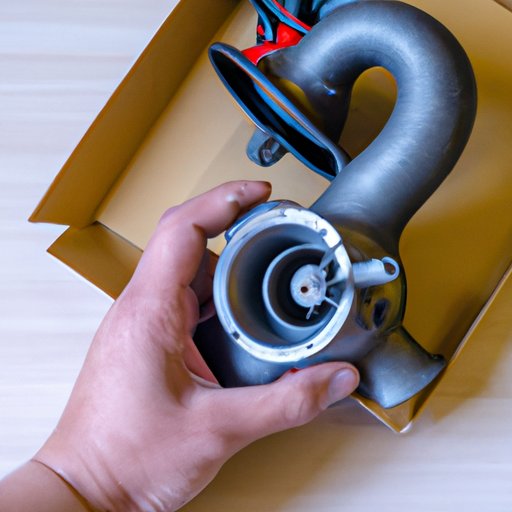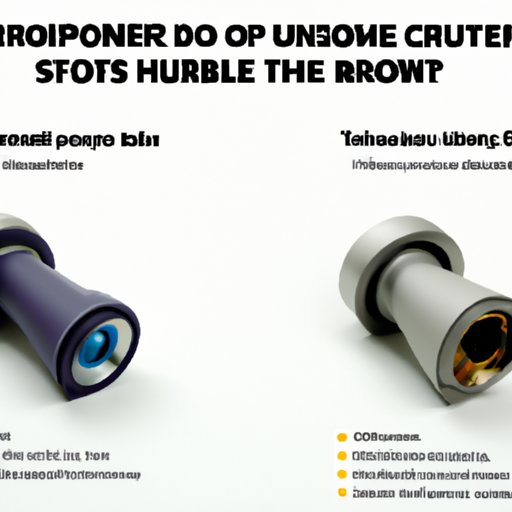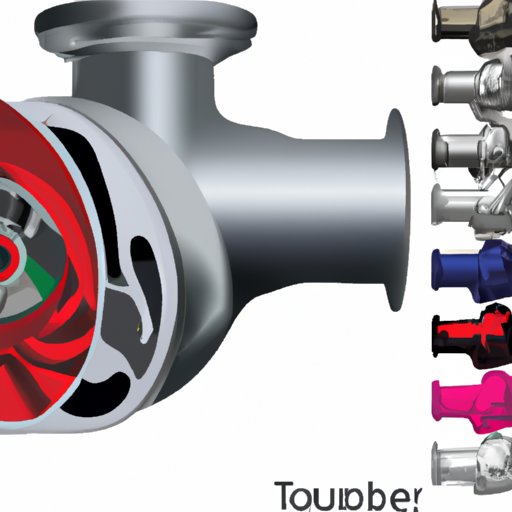Introduction
A turbocharger is an engine component designed to increase the power output of an internal combustion engine. It does this by forcing additional air into the engine’s cylinders, allowing it to burn more fuel and produce more power. The concept of turbocharging has been around since the late 19th century, but it wasn’t until the 1970s that turbochargers began to be used in production cars. Today, turbochargers are commonplace in many types of vehicles, from passenger cars to commercial trucks.
In this article, we will explore the basics of turbocharging technology. We will look at how a turbocharger works, its components and mechanics, as well as the advantages and disadvantages of using a turbocharger. We will also provide a step-by-step guide to installing a turbocharger.
Exploring the Basics: How Does a Turbocharger Work?
A turbocharger works by using exhaust gases from the engine to spin a turbine wheel. This turbine wheel is connected to a compressor wheel, which compresses the air entering the engine. By increasing the amount of air entering the engine, a turbocharger allows the engine to burn more fuel, resulting in increased power output. It is important to note that a turbocharger does not increase the displacement or size of the engine—it simply increases the efficiency of the existing engine.
When the engine is running, exhaust gases flow through the turbine wheel, causing it to spin. As the turbine wheel spins, it drives the compressor wheel, which compresses the air entering the engine. This compressed air is then mixed with fuel and combusted in the engine, resulting in increased power output. The faster the turbine wheel spins, the more air is compressed, resulting in increased power output.
A turbocharger can increase an engine’s power output by up to 50%, depending on the type of engine and the size of the turbocharger. This makes turbocharging a popular option for those looking to increase their vehicle’s performance without having to invest in a larger, more expensive engine.
A Deep Dive Into Turbocharger Technology
A turbocharger is composed of several components, including a turbine wheel, a compressor wheel, a bearing housing, and a wastegate. The turbine wheel is driven by exhaust gases from the engine, while the compressor wheel compresses the air entering the engine. The bearing housing holds the two wheels in place and provides lubrication, while the wastegate regulates the flow of exhaust gases.
The turbocharger is connected to the engine via a series of pipes and ducts. Exhaust gases from the engine flow through one pipe and into the turbine wheel, causing it to spin. The compressed air then flows out of the other pipe and into the engine, where it is mixed with fuel and combusted. The wastegate regulates the flow of exhaust gases, ensuring that the turbine wheel does not spin too quickly and cause the engine to overheat.
It is important to note that turbochargers can be either water-cooled or air-cooled. Water-cooled turbochargers use coolant to keep the turbocharger cool, while air-cooled turbochargers rely on the flow of air to keep the turbocharger cool. Water-cooled turbochargers are typically more efficient than air-cooled turbochargers, but they are also more expensive.
The Benefits of Turbocharging: Understanding the Mechanics
Turbocharging has several advantages over other forms of engine modification. For one, it is relatively inexpensive compared to other methods of increasing power output. Additionally, turbochargers are relatively easy to install and maintain, making them an attractive option for those looking to increase their vehicle’s performance without breaking the bank.
There are several different types of turbochargers available, each with its own advantages and disadvantages. Single turbochargers are the most common type of turbocharger, as they are relatively inexpensive and easy to install. Twin turbochargers provide increased power output, but they are more expensive and require more maintenance. Sequential turbochargers offer the highest level of performance, but they are also the most expensive and require the most maintenance.

Step by Step Guide to Installing a Turbocharger
Installing a turbocharger can be a complicated process, so it is important to take your time and follow the instructions carefully. Before beginning the installation, make sure you have all the necessary tools and parts. You will also need to consult your vehicle’s service manual for specific instructions.
The first step is to remove the old turbocharger. This involves removing the intake and exhaust manifolds, as well as any other components that may be connected to the turbocharger. Once the old turbocharger has been removed, you can begin to install the new one. This involves connecting the intake and exhaust manifolds, as well as any other components that may be necessary.
Once the new turbocharger is installed, you can begin the process of tuning the engine. This involves adjusting the boost pressure, fuel delivery, and other parameters to ensure that the engine is running optimally. This process can be complex, so it is best to consult a professional if you are not sure what to do.

Turbocharging 101: What You Need to Know
Before turbocharging your vehicle, there are a few things you should consider. First, it is important to make sure that your engine is in good condition and able to handle the increased power output. Additionally, it is important to consider the type of turbocharger you will be using, as different turbochargers have different levels of performance and require different levels of maintenance.
You should also consider the cost of turbocharging. While turbocharging can be relatively inexpensive, it can also be quite costly depending on the type of turbocharger you choose and the amount of work that needs to be done. Finally, it is important to consider the reliability of the turbocharger. A good quality turbocharger should last for many years with proper maintenance.

The Pros and Cons of Using a Turbocharger
Using a turbocharger can provide several benefits, including increased power output and improved fuel economy. Additionally, turbochargers can help reduce emissions, as they allow engines to burn fuel more efficiently. Turbochargers are also relatively easy to install and maintain, making them an attractive option for those looking to increase their vehicle’s performance.
However, there are also some drawbacks to using a turbocharger. One of the main drawbacks is the potential for turbocharger lag, which is when the turbocharger takes time to spool up and provide increased power output. Additionally, turbochargers require regular maintenance and can be expensive to replace if they fail.
Conclusion
In conclusion, turbocharging is a popular option for those looking to increase their vehicle’s performance. It can provide increased power output, improved fuel economy, and reduced emissions. However, it is important to consider the costs and potential drawbacks of using a turbocharger before investing in one.
We hope this article has helped you better understand how a turbocharger works and the advantages and disadvantages of using one. If you have any questions or would like more information, please feel free to contact us.
(Note: Is this article not meeting your expectations? Do you have knowledge or insights to share? Unlock new opportunities and expand your reach by joining our authors team. Click Registration to join us and share your expertise with our readers.)
